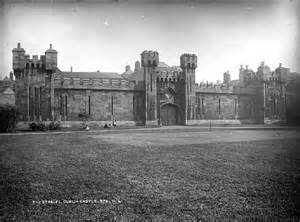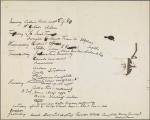What Was Happening At Dublin Castle On The 24th March 1916
As everyone I’m sure is aware, we are celebrating a 100 years since the 1916 Easter Rising and it has become our ambition to take a walk down memory lane to remember, retell and relive the events and moments of that week. One of the places that played its own significant role in the events of the Easter Rising was of course, the administration capital of Ireland, Dublin Castle.
Dublin Castle is situated on the site of the Black Pool, where Dublin derives her name from (Dubh Linn – dubh = black). Once a Gaelic ringfort, Dublin Castle also served many other purposes through the years and its origin can be dated back as far as the 930’s. During that time a Danish Viking Fortress stood on this site and became the main Viking military base and trading centre of slaves and silver.
In the 1170’s the Normans took over the Castle grounds to build their first fortification made from wood and stone. In 1230, commissioned by King John of England, a new castle, stronger and bigger was erected to defend the city. Thereafter the towers were erected; they were used as prisons and platforms for the archers and gunmen, from where they could protect the Castle against attack.
It is of course better known as the centre from where the English colonial administration operated from, and acted as the official residence for the Justiciar, Chief Lieutenant and visiting English Kings. It used to be the seat of Parliament and contained dungeons where state prisoners were held.
The Castle received a facelift in 1570. A Chapel, Clock Tower, Castle Gardens and Deputy’s House was built. Then disaster struck and the Castle burned down in the great fire of 1684 and had to be rebuilt. By the mid 1700’s the Castle was once again functioning after years of renovation.
By 1820, the Castle was mainly used by the army and the police and also the place where court was held. It was a meeting point for the rich and affluent where they could dance and eat to their hearts content, while the under privileged were starving outside the Castle gates.
In 1916, the rebellion started at noon on Monday the 24th April. At 12.10 pm, the DMP phoned the Military HQ at Parkgate to inform them that the Castle was under attack. Col. Cowan ordered men from the Royal, Richmond and Portobello Barracks’ to march to the Castle to defend the captured soldiers.
At noon, Sean Connolly’s (Irish Citizen’s Army) unit made an assault on Dublin Castle. During this attack they shot dead a police sentry, Constable O’Brien, who was in the process of shutting the Cork Hill Gate.
The rebels then overpowered the soldiers in the Guard House and tied them up. They failed to capture the Castle, unaware that it was so undermanned that day and then retreated to City Hall. The majority of the soldiers were at the Fairy House Races.
Lieutenant-Colonel Sir Matthew Nathan, head of administration in Ireland, was at his desk in Dublin Castle and remained a prisoner until the evening. While he was forced to remain in the Castle he communicated the events to London.
Another key figure at Dublin Castle that day was Thomas Bodkin, a young barrister from a prominent middle-class nationalist family. He was witness to the fighting all over town as he went out walking. He offered his services to the Red Cross’s Royal Army Medical Corps on Thursday evening and volunteered as a stretcher-bearer.
His duties included collecting the wounded and taking them to Dublin Castle. Dublin Castle had been serving as an emergency war hospital since early 1915. Small sheets of notepaper Thomas scribbled and sketched on survived. Thomas had taken it with him to the Castle.
The note is a letter to a friend, half-way written, telling him of the Rising and that there were very few stretcher-bearers there with him to help the wounded. Also, on the notepaper is a sketch of the Cork Hill entrance to Dublin Castle. This he must have doodled from inside the upper yard while waiting on more casualties.
The famous “Castle Document” was given to Eoin MacNeill on Monday the 24th of March 2016. This was a note stating that the leaders of the Volunteers were to be arrested by the British. It also stated that the Volunteers will have to be disarmed and that the British Army would occupy Dublin. Confusion reigned at the Castle as the authorities were trying to put the puzzle together – concerning the document and the weapons that were seized from the German ship Aud in Cork.
After the invasion of the Castle, the British Soldiers started making their way there to prevent a possible takeover. One soldier, a private Andrew Barry relates his side of the events that day as follow: “Bullets were smashing into the shops. A door opened, and an old woman dragged us inside. We ran out the back, over a wall, along a lane, and into the barracks, just as the second picket was waiting to move off, the old major in charge – we always had old officers – ordered us to load our rifles. We had exactly three rounds each.”
“The second pickets dashed out to the quay wall, and then charged across the bridge, making for the streets behind Guinness’s Brewery. They ran through streets “full of angry people, who pointed up at ‘The Shinners’ on the rooftops”.
At Christchurch, they were ambushed again, losing another man. “I saw the old major shooting at the rebels with his revolver. Might as well have been throwing stones.” Barry and his comrades followed the major through the side streets, down the cattle steps, and via a side door, into what they later discovered was Dublin Castle.
They were the first troops into the Castle. The Rising was half an hour old. Barry’s first direct encounter with the Citizen Army garrison of City hall and nearby buildings came when he and three others, including his brother, were ordered into a tiny room, which looked out into Dame Street, with orders “not to let them in!”. The room, however, was overlooked by the buildings on the other side of the street.
That Monday night, the room “took a terrible pasting”. The 10th battalion was kept in the Castle until the Saturday. The intervening days were a strange mixture of the banal and the deadly. While, the doomed Irish Citizen Army garrison of the City Hall ate bacon and eggs, tea and sandwiches, the Fusiliers wandered around the Castle without any food, dirty, constantly under sniper fire.
Sergeant Burke stepped out the door of the battalion’s billets in the verminous Ship Street Barracks, and was shot dead instantly. Searching for his body later, Barry and some comrades found themselves in a pitch-dark cellar in the Castle, filled with dead bodies, all stripped naked, ready for burial.
“We got out before finding Burke’s body. All the corpses looked alike.” On the Saturday as the Rising stuttered to a close, the troops were pulled out of the Castle. Before he went, Barry took a look at some of the weapons the rebels had been shooting at him and his comrades with – the same Howth Mausers he had brought ashore himself in 1914. – Private Andrew Barry, The Irish Times – Tuesday, April 24, 1984.
At 1.40 pm, 180 men in total arrived at the Ship Street entrance – 130 from the Royal Dublin Fusiliers and 50 from Royal Irish Rifles. Barry and Colonel M A Tighe of the Royal Irish Fusiliers met while he was making his way to the Royal barracks. They came under fire at Christchurch and City Hall and decided to split the party in tow. One party went down the long steps to the Ship Street entrance to the Castle, and Barry and 10 other men went via Ship Street Barracks to enter the Castle.
When Barry and his men entered the Castle there weren’t many soldiers fronting the takeover and he decided to put snipers in place to veer off the other snipers the Volunteers and Citizen Army had in the houses overlooking the Castle. It was here that Sergeant Burke was shot when he climbed up a ladder to decide where they would put the snipers.
The soldiers started coming into the area and they started firing at City Hall. Sean Connolly was shot at around two o’clock by one of the snipers operating from the Bedford Tower and slid down the roof as he raised the rebels’ flag.
The next thing the soldiers had to do was get the rebels out of City Hall. City Hall was occupied by rebels dressed in women’s garments and half of these rebels were indeed woman. As the rebels fled City Hall they left the garments lying on the road. By the evening the ground floor had been taken over by the British.
“By now the rebellion had been put down, and the aftermath was taking is fearful course. My grandfather was involved with the prisoners, censoring mail at the Courts Martial Court at Richmond Barracks. He returned to the 10th Battalion in Royal Barracks about 20th May
During the rebellion, I found many opportunities of nosing into places in Dublin Castle that were normally off limits to all but a very few. I knew some of the history of the Castle to appreciate the opportunities. For example, on a couple of nights, with a few of my troops, we slept in the pews of the Royal Chapel, on the cushions on which some of the highest in the land had sat during divine service. In the chaos that arose during the rebellion, it was a case of seizing any opportunity which would give one a respite,” Private Andrew Barry recalls.
Lieutenant Constance Markievicz, a member of the Irish Citizen Army, was fighting the British around Stephen’s Green on Easter Monday. Herself and the Citizen Army had to withdraw to the Royal College of Surgeons where they held out for six days before they were handed a copy of Pearse’s surrender order. They were taken to Dublin Castle to join James Connolly. After that they were transferred to Kilmainham Gaol. The rest is history…
The Castle still stands today and unlike the Post Office and other buildings no damage was caused during the Rising. It is one of Ireland’s main tourist attractions and hundreds of visitors make their way there every day of the week to enjoy a walk around the Castle grounds. Dublin Castle is still in use and plays host to European Union Presidencies, Heads of States, leaders of business, industry and government every year.











Ireland is a country where there are many castles with ghosts – shadows of a bloody past and to this day reminding living people of themselves.